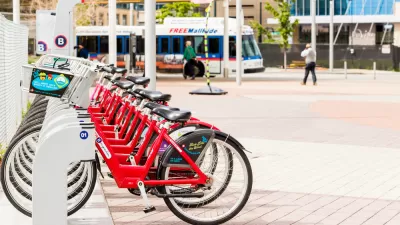A new study of the benefits of a bike lane project in Salt Lake City adds to the body of work suggesting that complete streets overhauls are a good investment for both the public and the private sectors.
"A growing body of evidence suggests that if bike lanes and parking removal are part of a general plan to slow traffic, everybody can win," according to a post by Michael Anderson. The latest example: Salt Lake City, where a recently released study "found that when parking removal was done as part of a wide-ranging investment in the streetscape — including street planters, better crosswalks, public art and colored pavement — it converted parking spaces to high-quality bike lanes and boosted business at the same time."
Anderson provides details on the nine-block bike lane project, located in the city's historic downtown business corridor, as well as some of the findings of the report. The bike lane required parking reductions, parking reconfigurations, and fewer vehicle travel lanes. The kicker on the difference the new bike lane made: sales rose 8.8 percent along the corridor after the street configuration overhaul, compared to 7 percent citywide.
Anderson is also careful to note, that the jump in bike traffic on the street that came as a result of the new bike lane is probably not solely responsible for the jump in sales: "But that's probably not the main reason for the sales jump. Instead — as on New York City streets, which found extremely similar results in a similar 2013 study of sales tax data — Salt Lake City's experience shows that bike lanes are typically best for business when they're part of a general rethinking of the street to make it a more pleasant place to linger."
FULL STORY: SALT LAKE CITY STREET REMOVES PARKING, ADDS BIKE LANES AND SALES GO UP

Planetizen Federal Action Tracker
A weekly monitor of how Trump’s orders and actions are impacting planners and planning in America.

Chicago’s Ghost Rails
Just beneath the surface of the modern city lie the remnants of its expansive early 20th-century streetcar system.

San Antonio and Austin are Fusing Into one Massive Megaregion
The region spanning the two central Texas cities is growing fast, posing challenges for local infrastructure and water supplies.

Since Zion's Shuttles Went Electric “The Smog is Gone”
Visitors to Zion National Park can enjoy the canyon via the nation’s first fully electric park shuttle system.

Trump Distributing DOT Safety Funds at 1/10 Rate of Biden
Funds for Safe Streets and other transportation safety and equity programs are being held up by administrative reviews and conflicts with the Trump administration’s priorities.

German Cities Subsidize Taxis for Women Amid Wave of Violence
Free or low-cost taxi rides can help women navigate cities more safely, but critics say the programs don't address the root causes of violence against women.
Urban Design for Planners 1: Software Tools
This six-course series explores essential urban design concepts using open source software and equips planners with the tools they need to participate fully in the urban design process.
Planning for Universal Design
Learn the tools for implementing Universal Design in planning regulations.
planning NEXT
Appalachian Highlands Housing Partners
Mpact (founded as Rail~Volution)
City of Camden Redevelopment Agency
City of Astoria
City of Portland
City of Laramie




























